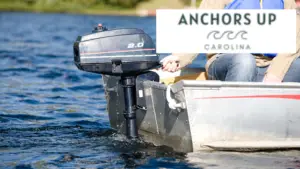Anglers who spend a significant amount of time on the water trolling find value in using an extra motor called a kicker. Notably, the kicker does more than just control speeds for trolling. Likely you have seen that extra small motor mounted on the back of a boat. Even as an avid boater I’ll admit I was confused by the importance. Here is what a kicker motor is used for.
What Is The Purpose Of A Kicker Motor
The purpose of the auxiliary boat engine, called a kicker, is for trolling. Kickers are highly beneficial to anglers for a multitude of reasons.
Auxiliary boat engines range between 10 and 25 horsepower. The amount of power required is determined by the size and weight of the vessel it is pushing.
Kickers have a multitude of benefits, including backup if main engine power is lost, fuel savings, and reduced wear and tear on the primary engine.
How Do You Steer A Kicker Motor
When I think of a kicker motor, what comes to my mind is a tiller handle. A tiller handle is on small marine outboard engines. The tiller is held in one hand and allows the operator to move the tiller left or right for steering and increase or decrease power by turning the throttle.
Don’t worry you won’t need to control your large vessel from the back of the boat by hand. The direction of the watercraft powered by a kicker is done is one of three ways.
Electronic Control
Kickers similar to electric trolling motors affixed to the bow of flats boats are controlled by remotes.
No need for the operator to stand at the helm. Instead, a lanyard worn around the neck with a remote serves the purpose. The operator can steer and adjust power from the remote control.
Importantly, one of the key benefits is allowing the operator to engage in fishing while driving. However, this does not mean you do not need to keep your eyes in the direction the boat is moving.
Steering The Main Engines
It should be noted that some auxiliary engines are fixed mounted. Fixed mounted means they can be raised or lowered but cannot be turned in a right or left direction.
The main engines steer fixed mounted kickers. Without question, the main engines remain in the water so the operator can steer the wheel to the left or right. Although the main engines are off, turning the wheel changes the boat’s direction when power is applied to the auxiliary engine.
Steering Bar
The final option is a kicker mounted to the steering bar of the primary engine or engines. Operators control the direction of the kicker while turning the wheel at the helm to the left or the right.
How Do You Control A Kicker Motors Speed
One of the primary reasons that anglers add a kicker is to control the vessel’s speed while trolling. Having precise control of speed while trolling is critical for catching more fish.
The auxiliary motors speed is controlled in one of two ways. The first is by remote control. The lanyard worn remote has buttons to increase or decrease engine power. Secondly, mounted at the helm is a throttle control. The handle is pushed forward or pulled back to increase or decrease trolling speed.
Kicker Motors Are A Safety Measure
Unfortunately, boat motors are prone to failure as they are exposed to a harsh environment day in and day out.
I have owned multiple boats and, fortunately, had only one experience with a breakdown. The failure resulted in needing to be towed back to the dock because I did not have a backup engine.
Undoubtedly the kicker adds a measure of safety. If the main power source fails, you can rely on the kicker to return to the dock. It should be noted that you will not have the option to run at high speeds. Instead, because of the reduced horsepower and size of the vessel it will be a slow journey but get you back safely nonetheless.
I would compare the auxiliary motor to insurance. The kicker has your back when you need it most beyond the benefits of trolling for fish.
Kicker Motors Burn Less Fuel
No question about it running boats is expensive, especially when the motor runs the entire day while trolling.
Comparatively, the main engine is far bigger and more powerful than the kicker. The combination of the two means that it burns more gas. Kickers are small; therefore, the gallons per hour or GPH will be significantly less.
Without question, shut down the primary engine and fire up the kicker to save money when trolling.
Kicker Motors Reduce Main Engine Running Hours
The most valuable aspect of adding and running a kicker is to reduce the number of hours on the main engine or engines.
Without question, the main engine or engines are far more expensive to replace in comparison to a kicker. Rather than running the main engines while trolling, the small auxiliary engine takes its place. Consider the number of hours a motor runs while trolling. When you factor in a complete season, the accumulated total is staggering.
Replacing the main or main engines breaks the bank. Prevent the need to replace the primary motors sooner than necessary by using a kicker when trolling. The kicker is far less expensive to replace.
Kicker Motors Are Essential For Trollers
Without a doubt, kickers are critical for anglers who troll on a consistent basis. Save money on fuel, and avoid racking up hours on the primary and more expensive main engines. Importantly, you can rely on an axillary engine to get you back to the dock in case of a primary engine failure.







